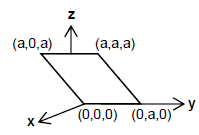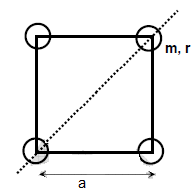JEE Main 2011 Paper - 1 with Solutions - JEE MCQ
30 Questions MCQ Test - JEE Main 2011 Paper - 1 with Solutions
SECTION – I (Total Marks : 21)
(Single Correct Answer Type)
This section contains 7 multiple choice questions. Each question has four choices (A), (B), (C) and (D) out of
which ONLY ONE is correct.
Q. A police car with a siren of frequency 8 kHz is moving with uniform velocity 36 km/hr towards a tall
building which reflects the sound waves. The speed of sound in air is 320 m/s. The frequency of the siren
heard by the car driver is
which ONLY ONE is correct.
building which reflects the sound waves. The speed of sound in air is 320 m/s. The frequency of the siren
heard by the car driver is
The wavelength of the first spectral line in the Balmer series of hydrogen atom is 6561 Å. The wavelength
of the second spectral line in the Balmer series of singly-ionized helium atom is
of the second spectral line in the Balmer series of singly-ionized helium atom is
| 1 Crore+ students have signed up on EduRev. Have you? Download the App |
Consider an electric field  where E0 is a constant. The flux through the shaded area (as shown in the figure) due to this field is
where E0 is a constant. The flux through the shaded area (as shown in the figure) due to this field is

5.6 liter of helium gas at STP is adiabatically compressed to 0.7 liter. Taking the initial temperature to be
T1, the work done in the process is
A 2 μF capacitor is charged as shown in the figure. The percentage of its stored energy dissipated after the switch S is turned to position 2 is
A meter bridge is set-up as shown, to determine an unknown resistance ‘X’ using a standard 10 ohm resistor.
The galvanometer shows null point when tapping-key is at 52 cm mark. The end-corrections are 1 cm and 2 cm respectively for the ends A and B. The determined value of ‘X’ is
A ball of mass (m) 0.5 kg is attached to the end of a string having length (L) 0.5 m. The ball is rotated on a horizontal circular path about vertical axis. The maximum tension that the string can bear is 324 N. The maximum possible value of angular velocity of ball (in radian/s) is
SECTION – II (Total Marks : 16)
(Multiple Correct Answers Type)
This section contains 4 multiple choice questions. Each question has four choices (A), (B), (C) and (D) out of
which ONE OR MORE may be correct.
Q. A metal rod of length ‘L’ and mass ‘m’ is pivoted at one end. A thin disk of mass ‘M’ and radius ‘R’ (<L) is attached at its center to the free end of the rod. Consider two ways the disc is attached: (case A). The disc is not free to rotate about its centre and (case B) the disc is free to rotate about its centre. The rod-disc system
performs SHM in vertical plane after being released from the same displaced position. Which of the following statement(s) is (are) true?
A spherical metal shell A of radius RA and a solid metal sphere B of radius RB (<RA) are kept far apart and
each is given charge ‘+Q’. Now they are connected by a thin metal wire. Then
A composite block is made of slabs A, B, C, D and E of different thermal conductivities (given in terms of a
constant K) and sizes (given in terms of length, L) as shown in the figure. All slabs are of same width. Heat
‘Q’ flows only from left to right through the blocks. Then in steady state
An electron and a proton are moving on straight parallel paths with same velocity. They enter a semiinfinite
region of uniform magnetic field perpendicular to the velocity. Which of the following statement(s) is / are true?
SECTION-III (Total Marls : 15)
(Paragraph Type)
This section contains 2 paragraphs. Based upon one of paragraphs 2 multiple choice questions and based on the other paragraph 3 multiple choice questions have to be answered. Each of these questions has four choices (A), (B), (C) and (D) out of which ONLY ONE is correct.
Paragraph for Question Nos. 12 and 13
A dense collection of equal number of electrons and positive ions is called neutral plasma. Certain solids containing fixed positive ions surrounded by free electrons can be treated as neutral plasma. Let ‘N’ be the number density of free electrons, each of mass ‘m’. When the electrons are subjected to an electric field, they are displaced relatively away from the heavy positive ions. If the electric field becomes zero, the electrons begin to oscillate about the positive ions with a natural angular frequency ‘wp’ which is called the plasma frequency. To sustain the oscillations, a time varying electric field needs to be applied that has an angular frequency w, where a part of the energy is absorbed and a part of it is reflected. As w approaches wp all the free electrons are set to resonance together and all the energy is reflected. This is the explanation of high reflectivity of metals.
Q. Taking the electronic charge as ‘e’ and the permittivity as ‘e0’. Use dimensional analysis to determine the
correct expression for ωp.
Paragraph for Question Nos. 12 and 13
A dense collection of equal number of electrons and positive ions is called neutral plasma. Certain solids containing fixed positive ions surrounded by free electrons can be treated as neutral plasma. Let ‘N’ be the number density of free electrons, each of mass ‘m’. When the electrons are subjected to an electric field, they are displaced relatively away from the heavy positive ions. If the electric field becomes zero, the electrons begin to oscillate about the positive ions with a natural angular frequency ‘ωp’ which is called the plasma frequency. To sustain the oscillations, a time varying electric field needs to be applied that has an angular frequency ω, where a part of the energy is absorbed and a part of it is reflected. As ω approaches ωp all the free electrons are set to resonance together and all the energy is reflected. This is the explanation of high reflectivity of metals.
Q. Estimate the wavelength at which plasma reflection will occur for a metal having the density of electrons
where these quantities are in proper SI units.
Paragraph for Question Nos. 14 to 16
Phase space diagrams are useful tools in analyzing all kinds of dynamical problems. They are especially useful in studying the changes in motion as initial position and momenum are changed. Here we consider some simple dynamical systems in onedimension. For such systems, phase space is a plane in which position is plotted along horizontal axis and momentum is plotted along vertical axis. The phase space diagram is x(t) vs. p(t) curve in this plane. The arrow on the curve indicates the time flow. For example, the phase space diagram for a particle moving with constant velocity is a straight line as shown in the figure. We use the sign convention in which positon or momentum upwards (or to right) is positive and downwards (or to left) is negative.
Q. The phase space diagram for a ball thrown vertically up from ground is
The phase space diagram for simple harmonic motion is a circle centered at the origin. In the figure, the two circles represent the same oscillator but for different initial conditions, and E1 and E2 are the total mechanical energies respectively. Then
Consider the spring-mass system, with the mass submerged in water, as shown in the figure. The phase space diagram for one cycle of this system is
SECTION-IV (Total Marks : 28)
(Integer Answer Type)
This section contains 7 questions. The answer to each of the questions is a single digit integer, ranging from 0 to 9.
Enter only the numerical value in the space provided below.
Q. A boy is pushing a ring of mass 2 kg and radius 0.5 m with a stick as shown in the figure. The stick applies a force of 2N on the ring and rolls it without slipping with an acceleration of 0.3 m/s2. The coefficient of
friction between the ground and the ring is large enough that rolling always occurs and the coefficeint of friction between the stick and the ring is (P/10). The value of P is
Steel wire of lenght ‘L' at 40°C is suspended from the ceiling and then a mass ‘m’ is hung from its free end. The wire is cooled down from 40°C to 30°C to regain its original length ‘L’. The coefficient of linear thermal expansion of the steel is 10-5/°C, Young’s modulus of steel is 1011 N/m2 and radius of the wire is 1 mm. Assume that L diameter of the wire. Then the value of ‘m’ in kg is nearly
Four point charges, each of +q, are rigidly fixed at the four corners of a square planar soap film of side ‘a’.
The surface tension of the soap film is γ. The system of charges and planar film are in equilibrium, and
where ‘k’ is a constant. Then N is
A block is moving on an inclined plane making an angle 45° with the horizontal and the coefficient of friction is m. The force required to just push it up the inclined plane is 3 times the force required to just prevent it from sliding down. If we define N = 10 μ, then N is
The activity of a freshly prepared radioactive sample is 1010 disintegrations per second, whose mean life is
109 s. The mass of an atom of this radioisotope is 10-25 kg. The mass (in mg) of the radioactive sample is
A long circular tube of length 10 m and radius 0.3 m carries a current I along its curved surface as shown. A wire-loop of resistance 0.005 ohm and of radius 0.1 m is placed inside the tube with its axis coinciding with the axis of the tube. The current varies as I = I0cos(300 t) where I0 is constant. If the magnetic moment of the loop is Nm0I0sin(300 t), then ‘N’ is
Four solid spheres each of diameter cm and mass 0.5 kg are placed with their centers at the corners of
a square of side 4 cm. The moment of inertia of the system about the diagonal of the square is N x 10-4 kgm2,
then N is
SECTION – I (Total Marks : 21)
(Single Correct Answer Type)
This section contains 7 multiple choice questions. Each question has four choices (A), (B), (C) and (D) out of
which ONLY ONE is correct.
Q. Extra pure N2 can be obtained by heating
Dissolving 120 g of urea (mol. wt. 60) in 1000 g of water gave a solution of density 1.15 g/mL. The molarity of the solution is
Bombardment of aluminium by a-particle leads to its artificial disintegration in two ways, (i) and (ii) as shown. Products X, Y and Z respectively are,
Geometrical shapes of the complexes formed by the reaction of Ni2+ with Cl– , CN– and H2O, respectively,
are
The major product of the following reaction is
Among the following compounds, the most acidic is
AgNO3(aq.) was added to an aqueous KCl solution gradually and the conductivity of the solution was
measured. The plot of conductance (L) versus the volume of AgNO3 is


















